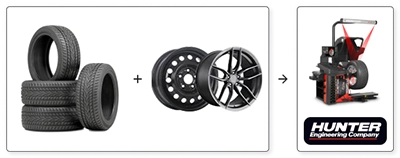Drive Safely This Fall: 5 Common Tire Mistakes to Avoid

Fall is a transitional season, marked by dropping temperatures, more frequent precipitation, and varying driving conditions. These changes can have a direct impact on your tires and, consequently, on the safety of your vehicle. Properly preparing your tires for the fall is essential to prevent accidents and extend their lifespan. Here are five common mistakes to avoid for safe driving during this period.
1. Ignoring the drop in tire pressure as temperatures fall
The first common mistake drivers make in the fall is neglecting the regular tire pressure check. As temperatures drop, so does tire pressure. In fact, for every 10°C drop, your tires can lose about 1 to 2 psi (pounds per square inch) of pressure.
Why it matters:
- Underinflated tires increase rolling resistance, which can lead to premature wear and higher fuel consumption.
- Poorly inflated tires also reduce grip, particularly on wet roads, increasing the risk of accidents.
What to do?
Check your tire pressure at least once a month in the fall and adjust it according to the manufacturer's recommendations. A small time investment can make a big difference in terms of safety and savings.
Check out our full article on tire pressure and how to find it
2. Delaying the switch from summer tires to winter or all-season tires
One of the riskiest mistakes in the fall is waiting too long to switch your summer tires. As temperatures drop below 7°C, summer tires lose their effectiveness. Their rubber hardens, which reduces grip, especially on wet or icy roads.
Why it matters:
- Summer tires become dangerous at low temperatures, as they are not designed to provide proper traction on cold or wet surfaces.
- Winter tires, on the other hand, are formulated to stay flexible and grippy in cold weather, while all-season tires offer an intermediate solution for milder climates.
What to do?
Plan to switch your tires before the first frost. If you live in an area where winter arrives quickly, opt for winter tires or all-season tires suited to your vehicle.
3. Forgetting to check tread wear
Fall is often a rainy season, and driving on wet roads with worn tires is dangerous. Insufficient tread depth significantly reduces grip and increases the risk of hydroplaning.
Why it matters:
- Worn tires cannot effectively channel water away from the road, which can lead to a loss of vehicle control and hydroplaning.
- The legal minimum tread depth in Canada is 1.6 mm, but it is recommended to replace tires well before reaching this limit, especially in the fall and winter.
What to do?
Check the tread depth with a tread depth gauge or the coin method. If the tread depth is below 4 mm, consider replacing your tires to avoid any accident risk.
Check out our full article on the subject
4. Failing to balance and align your tires in time
After a summer of rough roads and the reappearance of potholes, your tires can become misaligned or unbalanced. Poor alignment can lead to uneven tire wear and reduce your vehicle's handling.
Why it matters:
- Misaligned or unbalanced tires increase premature wear, reduce braking efficiency, and can cause annoying vibrations while driving.
- Poor alignment can also cause the vehicle to drift to one side, increasing the risk of accidents.
What to do?
Have your tires' alignment and balance checked every fall, especially after hitting potholes or curbs. This ensures your tires wear evenly and you maintain optimal control of your vehicle.
Check out our full article on the subject
5. Neglecting tire rotation
Another common mistake is neglecting tire rotation in the fall. By not switching the position of your front and rear tires, you risk uneven wear, especially if your vehicle is front- or rear-wheel drive.
Why it matters:
- Regular rotation ensures that all tires wear evenly, thus extending their lifespan and maintaining optimal grip.
- It can also improve stability and driving comfort, especially on wet or slippery roads.
What to do?
Follow the manufacturer's recommendations for tire rotation (typically every 10,000 km or every two oil changes). Fall is the perfect time to plan this service, along with other seasonal checks.
Don't forget to consult our full article on this topic
Conclusion
Fall brings its share of driving challenges, and taking care of your tires is essential to ensure your safety on the road. By avoiding these five common mistakes, you not only extend the life of your tires, but you also drive with peace of mind, no matter the weather conditions. Don't forget to check out our tire catalog and schedule an appointment with a professional for a full tire checkup before winter.


